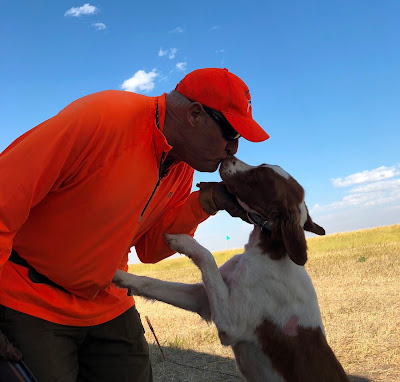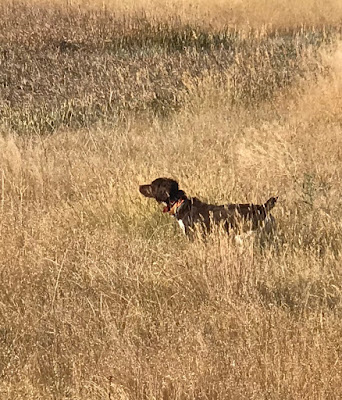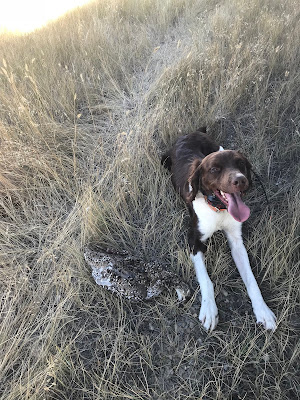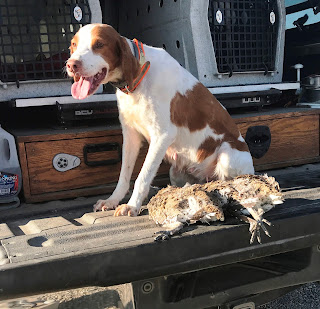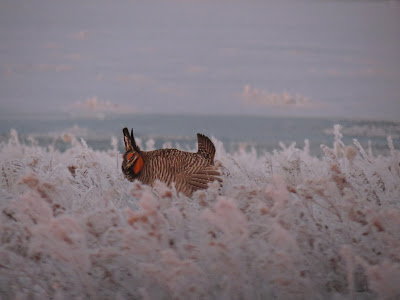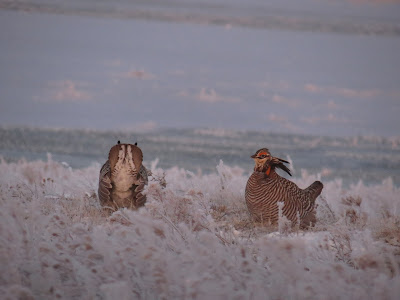 |
| Southern AZ Mearns Country |
Each time I load up and head to Arizona, I'm already smiling. It's a hard two days, sometimes two and a half days, to get to Tucson, but the country is so stark and honest, I think it's beautiful. This December (2018) was no exception. I dragged my camper to NM and dropped it with a friend who kindly put in hookups near his barn. Since it was raining hard in Mearns country, I stayed for a few days and hunted Blue (Scaled) Quail.
New Mexico never disappoints. Good years, bad years, cold years, hot years, it's what you expect. Over the years, I've been rained on, hailed on, snowed on, blown over, sunburned, frozen, and everything in between- that's New Mexico! The birds are just as hardy. Having a drought? OK, the covey sizes are small...but, there still are coveys. Having a banner year? OK, you can walk in any direction, and you will find a covey within 200 yards. Blues are fast, tough, and will run like the wind until you force them to fly. Many bird hunters will not hunt them, because they don't typically hold like a bobwhite. I think they are missing out. It takes some thinking, scheming, and good dog work to really be successful. Although, I know several guys that hunt them without dogs and do quite well.
 |
| Blue (Scaled) Quail |
Pearl and I put out at a place I call "Quail Valley" from past years hunting the area. Right away, she was birdy, running through the mesquite with purpose, nose on the ground, then, nose up in the air. She kept working up to the side of the bowl shaped depression, and I kept trying to get her back down in the grass, where there was at least some cover for the birds. There weren't going to be any birds up on the sides where the cover was very sparse. Mumbling under my breath, I was marching through the sand, when she locked up about 50 yards from me. I picked up the pace, by now, and swung around her by 10 yards, aiming for a point 20-30 yards in front. A single popped up and headed for safety, but the Ithaca Model 100 SKB 20 ga. dropped him easily. Pearl made a nice retrieve to hand and she headed out again along the side of the bowl. I was marveling at how these birds can disappear in almost NO cover, when one flushed from almost underfoot and sped away. Then, I understood, I we were in the midst of a feeding covey. Pearl pointed again- another single in the bag. Once more she pointed, and the single blasted away, but a double from behind her went the other direction. I dropped the single and swung on the double, but it was a sucker shot since I had to swing almost 180 degrees to even find the retreating gray blurs.
 |
| Pearl and 3 of her 4 Blues that cast. |
We eventually moved out of that covey and started working back to the truck. As I called her to me and took the picture, I noticed she kept looking to her left as I was setting things up. Just as I released her, she tore off to her left, S-turned a few times and locked up about 75 yards away! On the rise of about 20 birds, I dropped another one and she put it in my hand. A few yards later, she pointed, and as I was walking in on her, the bird blew up behind me, from a mesquite bush. I heard more than saw it, so I let it go. It was a good afternoon in the desert.
The next day, it was time to continue on to Arizona and a date with the Mearns in the southern Arizona mountains (elev. approx 5500').
 |
| Male Mearns Quail |
After two days of Mearns, I turned to the north and went searching for some Gambels Quail in the desert.
 |
| The Beast parked in typical Gambels habitat. |
We were back to boots, once more, as we navigated the rough, rocky roads north of Tucson. 4 or 5 different types of cactus covered the ground. The birds use the cactus for food and for protection. I've written about boots before: click here to view the video about the boots- https://youtu.be/f6nlipXdB6s.
Click here to read the BLOG post- http://www.abirdhuntersthoughts.com/2015/06/dog-boots-need-them-or-not-which-brand.html
 |
| Texas Boots from motorcycle inner tubes. |
I put my other girl on the ground, Ruby. She made a methodical cast and found two coveys. I harvested one bird from the first covey, but the second covey was a little wiser. They flushed out the other side of a mesquite bush, from the thick grass. I heard them go, but only saw gray dots on the horizon. Next, I moved to an area I hunted several years in the past. It was way back in, down a stream bed, over a rocky trail, and through a gate that's seen better days. We pulled up to a dry water tank surrounded by a substantial corral. I booted my 18 month old pup, Blue. He came off the tailgate and immediately went into hot scent mode. His body was crouched, tail moving like a buzz saw, running with sharp turns, and barely controlled enthusiasm. After 5 minutes of this, he spun and locked down hard on a clump of grass. I kicked but it was empty. I reached and tapped him on the head, and off he went, again. Twenty yards away, he spun and locked up again! This time, the bird blasted out, and I dropped him on the second shot. Blue released at the shot and chased the falling bird. Unfortunately, he ran right into a large patch of cactus. He yelped and jumped back into a cholla cactus, yelped again and finally stopped to bite at the pieces of cactus stuck in him. I grabbed my comb I carry for such an event, grabbed his collar, calmed him down, and flicked the cactus off with the comb. Then, I told him to "Fetch it up!" He moved with quite a bit more intention this time, avoiding the cactus and moving to where the bird dropped. A retrieve to hand finished the work. It was his first wild quail- a Gambels!
 |
| Blue and his first bird. |
The next day, we traveled back to New Mexico to spend a few days trying to find some bobwhite quail. I've been into them before, but haven't been successful in the past few years. If I could get one in the bag, I would have harvested all four species of Southwest Quail.
 |
| On the ranch. |
We were invited to a ranch right up against the Texas line. It had not been hunted, and it held bobwhites. Let's go!, I said. At only 100,000+ ac., I'm not sure we would have enough to hunt, but we decided to give it a shot, anyway.
 |
| Perfect habitat! |















